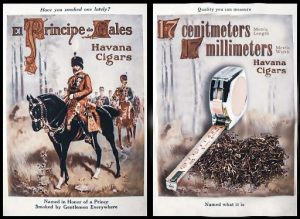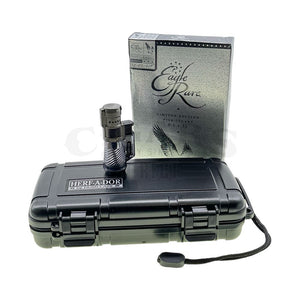The Cigars Direct Guide to Cigar Shapes and Sizes
Cigarettes are simple. Want a smoke? Buy a pack. That’s it. Cigars, on the other hand, come in a dizzying array of shapes and sizes: Corona, Churchill, Robusto, Panatela, Lonsdale… the list goes on and on. What does it all matter? Can’t a guy (or girl) just get a cigar and call it a day? You can. But for those who want to understand things a bit more clearly, we put together this basic guide to cigar shapes and sizes.
 “Parejo” means “straight” or “flush” in Spanish, and it’s the classic cigar shape and size. The open foot (that you light) is flat, and the cap (that you put your mouth on) is rounded. Parejos come in a ton of sizes. Let’s run down the list.
“Parejo” means “straight” or “flush” in Spanish, and it’s the classic cigar shape and size. The open foot (that you light) is flat, and the cap (that you put your mouth on) is rounded. Parejos come in a ton of sizes. Let’s run down the list.
 If it’s not a Parejo, it’s a Figurado. Instead of a rounded cap, Figurados generally come to more of a point at the head. Why? Well, one of the benefits is the delivery of a more concentrated draw, with more concentrated flavors. Let’s take a look at a few Figurado shapes:
If it’s not a Parejo, it’s a Figurado. Instead of a rounded cap, Figurados generally come to more of a point at the head. Why? Well, one of the benefits is the delivery of a more concentrated draw, with more concentrated flavors. Let’s take a look at a few Figurado shapes: 
 Which one is more appealing?
Plus, it could always be worse. What if the Germans had gotten to Columbia first and instead we had to say things like “Großartig Zigarre” or “Schlechter Rauch” (“great cigar” and “bad smoke,” respectively)? The Spanish don’t seem so bad, now does it? Have any more questions about cigar shapes and sizes? Let us know!
Which one is more appealing?
Plus, it could always be worse. What if the Germans had gotten to Columbia first and instead we had to say things like “Großartig Zigarre” or “Schlechter Rauch” (“great cigar” and “bad smoke,” respectively)? The Spanish don’t seem so bad, now does it? Have any more questions about cigar shapes and sizes? Let us know!
The Straight Shooters of the Cigar World: Parejos
 “Parejo” means “straight” or “flush” in Spanish, and it’s the classic cigar shape and size. The open foot (that you light) is flat, and the cap (that you put your mouth on) is rounded. Parejos come in a ton of sizes. Let’s run down the list.
“Parejo” means “straight” or “flush” in Spanish, and it’s the classic cigar shape and size. The open foot (that you light) is flat, and the cap (that you put your mouth on) is rounded. Parejos come in a ton of sizes. Let’s run down the list.
- Corona – 5 or 6 inches, with a ring gauge between 42 and 44. This is a pretty standard cigar size, offering a nice concentrated flavor and a snug draw. For a recommendation, try the Cohiba Black Corona or 5 Vegas Classic Corona.
-
- What’s a ring gauge? The ring gauge is the diameter of the cigar, measured in 64ths of an inch. If you see a cigar that’s 6x34, the cigar is 6 inches long and 34/64ths of an inch in diameter. Gauge affects burn rate, draw, and a number of other factors, but that’s a story for a different day.
- Corona Gorda – this is a chubby corona, with a similar length, but a ring gauge around 46-48. Want to light one up? Test out the Tatuaje Black Corona Gorda or the Davidoff Escurio Corona Gorda.
- Double Corona – a much longer corona that’s 7.5-8.5 inches long and a little fatter, with a ring gauge of around 50. Sample the CAO Gold Double Corona or Punch Rare Corojo Double Corona to get a feel for this size.
- Petit Corona - there sure are a lot of damn Coronas! This one’s the itty bitty one: 5 inches or less by 42. Check out the Rocky Patel Sungrown Petit Corona or Arturo Fuente Gran Reserva Petit Corona Natural to experience this cigar size.
- Churchill – the Churchill is similar to the double corona, but carries that classic name that makes all the difference. This one is around 7 inches, with a ring gauge in the 48-50 range. Try the Oliva Serie O Churchill or Ashton Classic Churchill for one of the ultimate cigar experiences.
- Gordo – it’s huge! 6-7 inches long, with a ring gauge of 60. Some have even been spotted in the wild up to 8 x 70. (No, we’re not compensating for anything, why do you ask?). Get large with the Camacho Connecticut Gordo or Gurkha Ninja XO Gordo.
-
- What’s up with huge ring gauges? Well, the simple answer is, they’re popular! Cigar manufacturers give the people what they want, and the people definitely want big ring gauges. “But why?” you might ask. Well, a fatter cigar allows a blender to use a more diverse blend of tobacco leaves in the filler, leading to a more complex and interesting smoke. It still has to taste balanced, of course, but the possibilities generally expand along with the ring gauge.
- Lancero – long and thin, the Lancero is 6.5-7.5 inches, with a 38 and 42 ring gauge. You can see this size in the Montecristo Original No. 1 Lancero or Alec Bradley Post Embargo Lancero.
- Panatela – long and even thinner. The Panatela is 6.5-7 inches, with a ring gauge of 28-38. Experience this long and light smoke in the Baccarat Original Panatela or Padron Thousand Series Panatela Natural.
- Lonsdale – about 6.5 by 42, the Lonsdale is thin-ish by modern standards. You can smoke one by getting the Oliva Connecticut Reserve Lonsdale or Rocky Patel Decade Lonsdale.
- Robusto – very popular. 4.75-5.5 inches long, with a ring gauge between 48-52. Pick up the CAO L’Anniversaire Cameroon Robusto or Cain Habano 555 Robusto to see what all the hype is about.
- Toro – the Toro is a Robusto that lifted over the summer. They measure around 6x52. Grab the Davidoff Yamasa Toro or H. Upmann Havoc Toro for example.
Smoke it from the Pointy End: Figurados
 If it’s not a Parejo, it’s a Figurado. Instead of a rounded cap, Figurados generally come to more of a point at the head. Why? Well, one of the benefits is the delivery of a more concentrated draw, with more concentrated flavors. Let’s take a look at a few Figurado shapes:
If it’s not a Parejo, it’s a Figurado. Instead of a rounded cap, Figurados generally come to more of a point at the head. Why? Well, one of the benefits is the delivery of a more concentrated draw, with more concentrated flavors. Let’s take a look at a few Figurado shapes: 
- Perfecto. A Perfecto symmetrically tapers off at both ends and has a bulge in the middle (sound familiar?). Perfectos may also be called “Exquisitos” or “Double Figurados.” Want to light one up? Check out the Obsidian Original Double Perfecto.
- Torpedo & Belicoso. This is often used as a catchall term for Figurado cigars, but a Torpedo shape features a tapered head. People often say it looks like a torpedo, how about that? A Belicoso is supposed to be shorter and tapers a bit more dramatically than a Torpedo, but the cigar world is not perfectly standardized when it comes to them. Want one? Give the Rocky Patel Sungrown Torpedo a chance.
- Pirámide / Pyramid. These cigars come to a point like the Torpedo, but the tapering starts right at the foot. This, you can guess, gives it a more pyramid-like shape. Want to get Egyptian on your humidor? Order the Ashton Cabinet Series Pyramid.
- Culebra. A Culebra is a unique style of cigar created by twisting together three long & thin Panatelas cigars. Culebra means “snake” in Spanish, but this cigar pack looks more like a snake orgy, in our opinion (“orgía de serpientes,” thanks Google Translate).
Where do Cigarillos fit in?
They don’t. A cigarillo is small enough to be considered its own thing. It’s bigger than a cigarette but smaller than typical cigar shapes and sizes. Cigarillos are a super popular choice for a casual smoke that doesn’t take an hour long-time commitment. They’re easy to find at almost any convenience store or gas station, and they come in a bunch of tasty flavors. You might even get a little plastic nub to munch on while you smoke. What’s not to love?Why isn’t any of this in English?
Well, while the English and French were busy carving out North America, Spain and Portugal were working on Latin America, South America, and the Caribbean Islands. And since those are the places where cigars and cigar shapes and sizes originated, all the naming was done in the languages of those countries, along with a mix of native words. In fact, according to the scholars of Wikipedia, the word “cigar” originally derives from the Mayan word “Sikar” ("to smoke rolled tobacco leaves"). On top of that, many cigar manufacturers preferred emotive, theatrical names, rather than technical, explanatory names. It makes sense. Would you rather smoke a “La Gloria Cubana Lonsdale” or a ‘Seventeen-centimeter by seventeen-millimeter tobacco cylinder?” Compare these two ads: Which one is more appealing?
Which one is more appealing?














